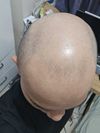community Red Ginseng Extract Promotes the Hair Growth in Cultured Human Hair Follicles
The conversation is about hair loss treatments, specifically discussing the effectiveness of Red Ginseng Extract in promoting hair growth. Other treatments mentioned include Minoxidil, finasteride, and RU58841.
